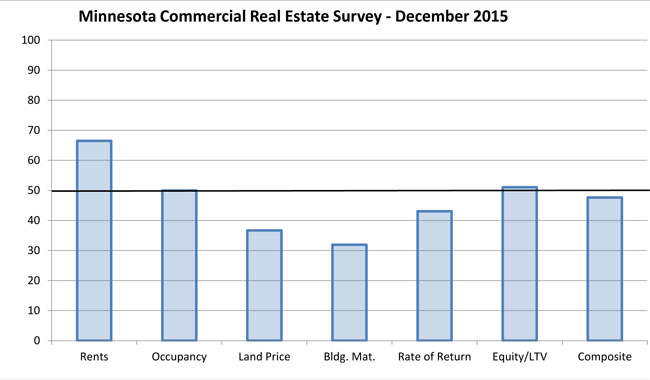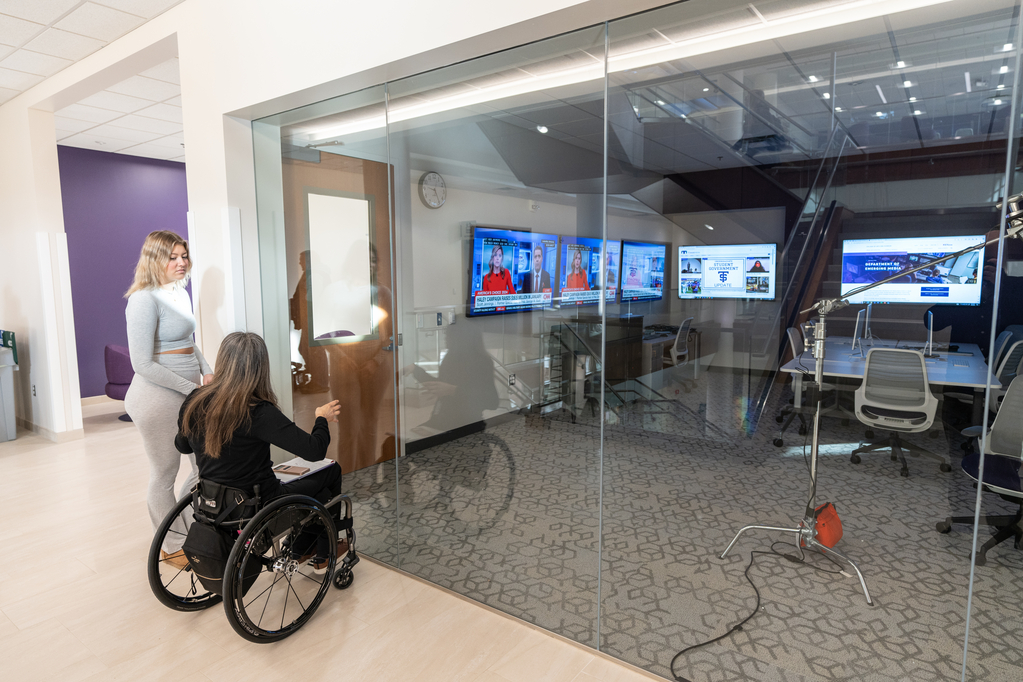Leaders in the field of Minnesota commercial real estate expect general economic conditions will continue to improve and the overall level of commercial real estate development and acquisition activity in two years will be similar to today.
That is the theme of the 10th Minnesota Commercial Real Estate Survey that was conducted in December 2015. The semiannual poll of 50 Minnesota commercial real estate leaders from the fields of development, finance and investment is conducted by the Shenehon Center for Real Estate at the University of St. Thomas’ Opus College of Business.
In all 10 surveys the same group of 50 industry leaders have been polled on their expectations of future commercial real estate activity in six categories: rents, occupancy levels, land prices, cost of building materials, rate of return and equity requirements. Their responses are used to create index scores that can be compared over time. Scores higher than 50 represent a more optimistic view of the market over the next two years; scores less than 50 represent a more pessimistic view.
“While there was optimism in some of those six areas and pessimism in others, overall the composite index of all survey questions has moved in a slightly positive, more optimistic direction,” said Herb Tousley, director of real estate programs at the university.
The composite score for the December 2015 survey stands at 48, a two-point improvement from June 2015.
“Expectations for conditions for development and acquisitions two years from now have improved slightly since the June 2015 survey,” Tousley added. “Based on December’s survey results, our panel expects that even if interest rates increase modestly, development and acquisition activity will continue at near-present levels for the next two years.”
In earlier surveys, there was a larger variations of responses to the six questions. Responses to the December 2015 survey were more uniform. Here’s a look at the panel’s responses for each of the questions.
Price for space
The index score for rental rates remains positive at 66 for the third-consecutive survey, which Tousley said is “an indication that our panel is still expecting strong rent growth for the next two years.”
The index for occupancy levels moved from 56 to a more-neutral 50. While this index has been steadily declining from a high of 66 in 2013, a neutral score of 50 “reflects the panel’s belief that occupancy rates will remain at current levels and that in the next two years there will be little absorption of additional space,” Tousley said. “Despite the decrease to a neutral level, the panelists remain optimistic that rents will continue to increase over the next two years.”
Land prices
The panel’s outlook for land prices continues to reveal an expectation that land prices will continue to increase. The land-price index increased slightly, moving from 35 in the previous survey to a slightly less pessimistic 37 in December 2015.
“Any increase in land prices increases total project costs, which is a hindrance to new development, making it more difficult to obtain financing and adequate returns for investors,” he said.
Building materials
The building-material index moved from a negative 29 to a somewhat-less pessimistic 32.
“That reflects the panel’s opinion that building-material price increases are expected to moderate slightly,” Tousley said. “Any moderation in price increases will be favorable for future development.”
Return for investors
The index for investors’ returns increased from 41 to 43.
“The consensus of the panel seems to indicate that investors expect returns will be higher in two years,” Tousley said.
“There was a concern that interest rates that have been at record-low levels for the past seven years will be higher two years from now, requiring higher rates of return on future investments. Investors will continue to seek out quality investments but they are being much more diligent about how they price risk and evaluate return when considering their investment options,” he said.
Required equity
The index for the amount of equity required by lenders dropped from 53 to 51.
“This indicates the panel’s belief that credit will still be available for good projects and that lenders will not be likely to increase their equity requirements above current levels in the coming two years,” he said.
Summary
“It appears that our panel’s expectations of higher land costs, the higher cost of building materials and investors’ expectations of higher returns continue to be the primary culprits driving the composite index to a slightly below-neutral level,” Tousley said. “Despite the headwinds created by higher project and acquisition costs, the panel expects general economic conditions in our area will continue to improve.
“Higher revenues in the form of higher rent will offset much of the expected increase in the price of land and building materials, allowing owners and investors to achieve their required returns and development to move forward.”
More information
Additional details can be found on the Shenehon Center’s website.








